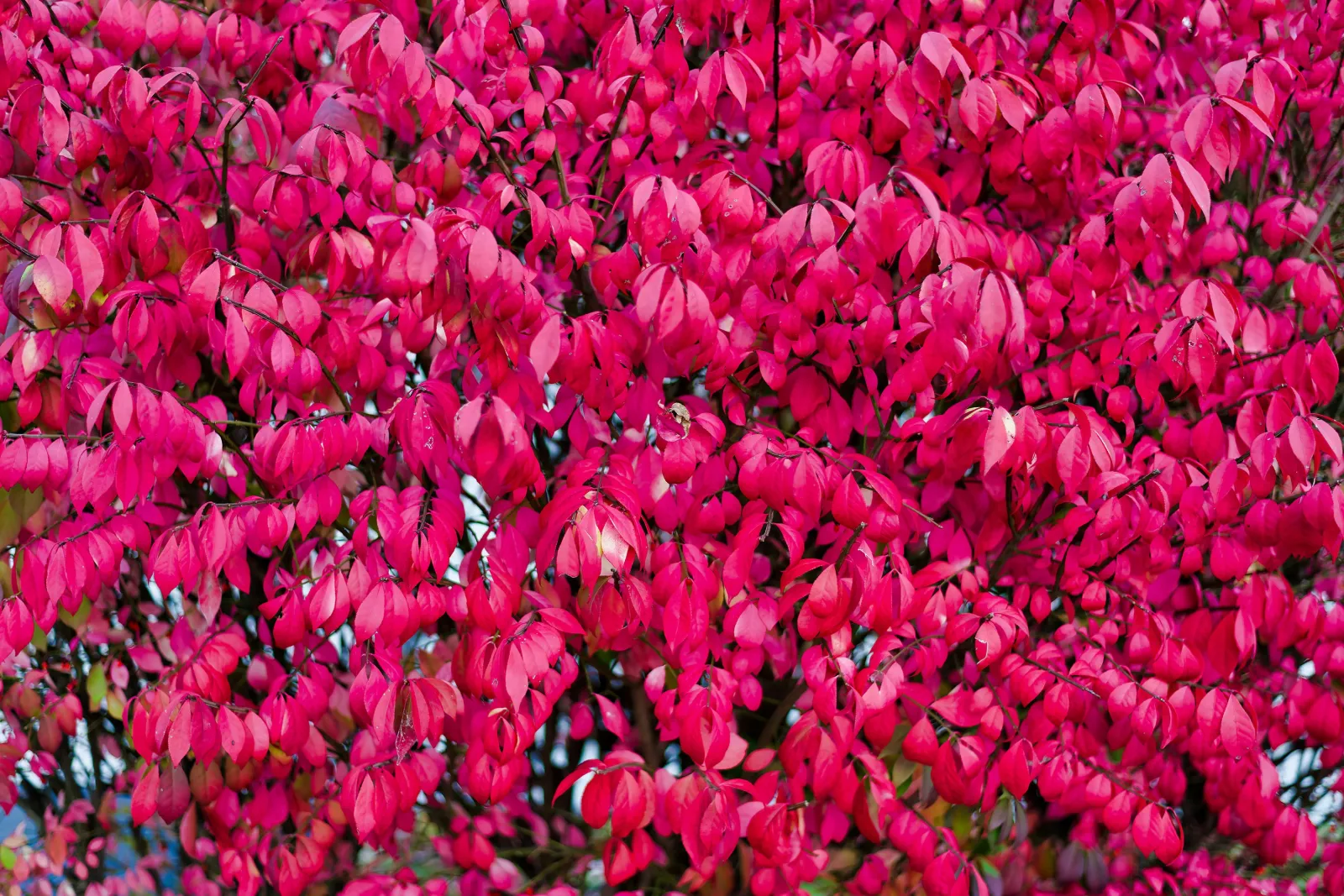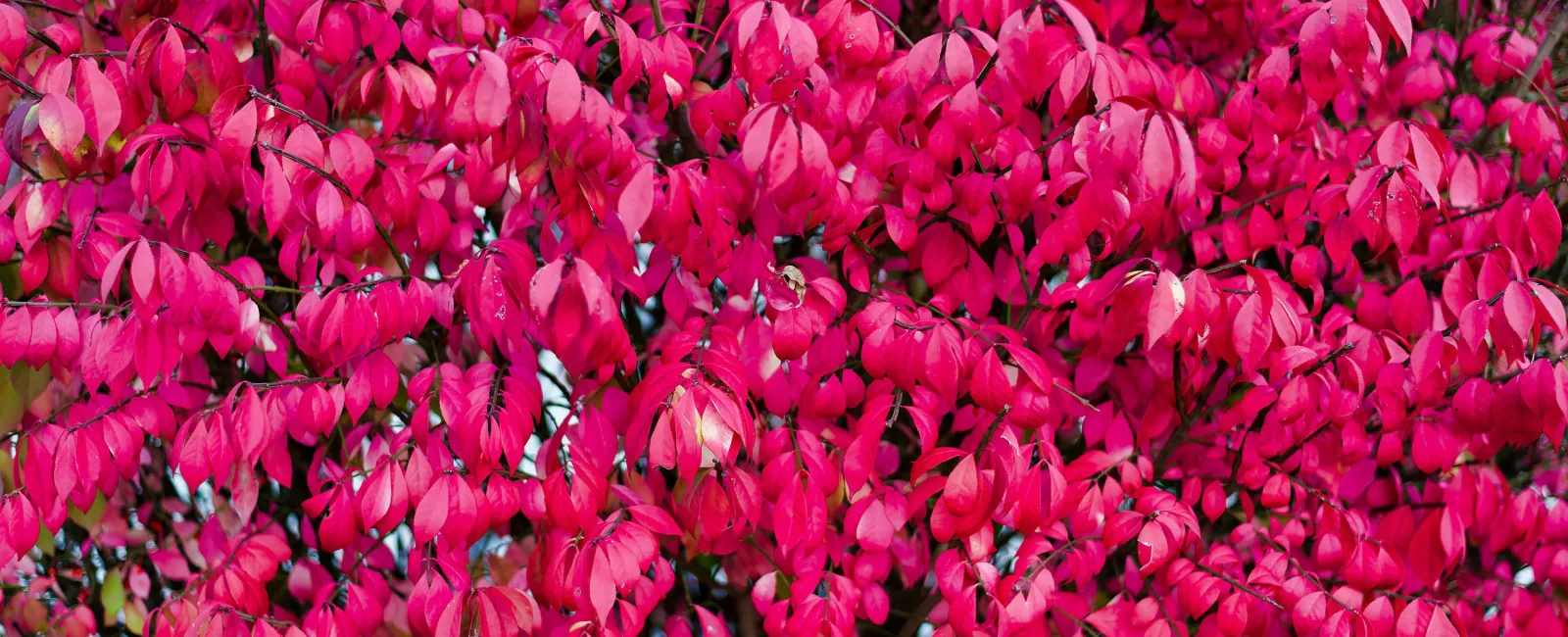Imagine a landscape set ablaze with vibrant crimson hues - not by fire, but by the spectacular autumn display of the burning bush. This captivating ornamental shrub, scientifically known as Euonymus alatus, has long been a favorite among gardeners and landscapers alike.
What is a Burning Bush?

The burning bush, scientifically known as Euonymus alatus, is a deciduous shrub native to northeastern Asia. It's part of the staff vine family (Celastraceae) and is known by several other common names, including winged spindle, winged euonymus, or simply euonymus.
The plant gets its evocative name from its most striking feature: its leaves turn a brilliant, fiery red color in autumn, making the entire shrub look aflame. This spectacular display has made the burning bush a popular ornamental plant in many parts of the world, particularly in North America.
Physical Characteristics of the Burning Bush Plant
Size and Shape
Burning bushes typically grow to 15-20 feet (4.5-6 meters) with a similar spread, though they can be kept smaller through regular pruning. They have a rounded to wide-spreading form, often growing as wide as they are tall.
Leaves
The burning bush leaves are simple, elliptical to obovate, and arranged oppositely on the stems. They're about 1-3 inches (2.5-7.5 cm) long and have finely toothed margins. The leaves are dark green in spring and summer, but they truly live up to the plant's name in autumn, turning a brilliant scarlet red.
Stems
One of the burning bush's distinctive features is its stems. They have thin, corky ridges or "wings" running along their length, which gives rise to another of its common names, "winged euonymus."
Flowers and Fruit
In late spring, the burning bush produces small, inconspicuous, greenish flowers. These develop into red capsules that split open in fall to reveal orange seeds. While not as showy as the autumn foliage, these fruits add to the plant's ornamental value and are attractive to birds.
Growing and Caring for Burning Bushes
Climate and Hardiness
Burning bushes are hardy in USDA zones 4-8 and can tolerate winter temperatures as low as -30°F (-34°C). They're adaptable to various climates but perform best in areas with distinct seasonal changes, promoting the most vibrant fall color.
Sunlight Requirements
Burning bushes should be planted in full sun for the best fall color. They can tolerate partial shade, but too much shade can result in leggy growth and less impressive autumn foliage.
Soil Preferences
These shrubs are adaptable to various soil types but prefer well-draining, slightly acidic to neutral soil (pH 6.0-7.0). They can tolerate poor soils but will thrive in more prosperous, loamy conditions.
Watering Needs
Once established, burning bushes are relatively drought-tolerant. However, regular watering during dry spells will help maintain healthy growth and vibrant fall color. Young plants should be watered more frequently until they're established. We install irrigation systems in Woodstock, Roswell, Alpharetta, and nearby areas.
Fertilization
Burning bushes generally require little fertilization if planted in reasonably fertile soil. If growth seems slow or foliage appears pale, a balanced, slow-release fertilizer can be applied in early spring. However, trees and shrubs require more fertilization, so here at O'Neill Landscape Group, you are covered for all your fertilization needs.
Pruning
While burning bushes can be left to grow naturally, they respond well to pruning and can be shaped into hedges or more formal forms. Pruning should be done in late winter or early spring before new growth begins. Regular pruning can help control the plant's size and promote denser growth. Check out the pruning services we offer here.
Ecological Considerations
While the burning bush has been a popular landscaping plant for many years, it's important to note that it has become invasive in many parts of North America. Its adaptability, prolific seed production, and appeal to birds (which spread the seeds) have allowed it to escape cultivation and establish itself in natural areas.
In some states, particularly in the northeastern United States, the sale and cultivation of burning bushes have been restricted or banned due to their invasive potential. They can form dense thickets that outcompete native vegetation, altering natural ecosystems.
For this reason, many gardeners and landscapers are now seeking native alternatives that provide similar autumn colors without the ecological risks. Some options include:
- Red Chokeberry (Aronia arbutifolia)
- Virginia Sweetspire (Itea virginica)
- Highbush Blueberry (Vaccinium corymbosum)
- Oakleaf Hydrangea (Hydrangea quercifolia)
These native shrubs can provide beautiful fall colors and valuable resources for local wildlife without the risk of becoming invasive.
Cultural Significance
The term "burning bush" has significant cultural and religious connotations, particularly in Judaism, Christianity, and Islam. In the biblical book of Exodus, God appears to Moses as flames coming from a bush that was not consumed by the fire. This "burning bush" became where Moses was called to lead the Israelites out of Egypt.
While the Euonymus alatus shrub is not directly related to this biblical account (the biblical burning bush was likely a different species entirely, possibly Acacia), its common name does evoke this powerful imagery. The shrub's fiery autumn appearance can serve as a vivid metaphor for the biblical story.
In landscape design and gardening, the burning bush has been prized for its ability to create focal points and add dramatic splashes of color to autumn gardens. Its popularity in the 20th century led to widespread planting in North America and Europe in parks, campuses, and home gardens. If you need assistance planting or renovating your yard, contact us here.
Alternatives and Future Outlook
Given the ecological concerns surrounding the burning bush, many gardeners and landscapers are now looking for alternatives that can provide similar aesthetic benefits without the environmental risks. In addition to the native North American species mentioned earlier, cultivars of the burning bush have been developed to be sterile, reducing their invasive potential.
One such cultivar is 'Rudy Haag,' a dwarf variety that grows only about 3-5 feet tall and produces few seeds. While this cultivar addresses some invasive concerns, it's still important to check local regulations and ecological recommendations before planting.
The horticultural industry continues to develop plants that combine the desirable traits of popular ornamentals like the burning bush with better ecological compatibility. This trend towards "natives"—cultivars of native species—and the increasing emphasis on environmental gardening will likely shape the future of landscape design.
Conclusion
With its spectacular autumn display, the burning bush has long been a favorite in gardens and landscapes. Its ability to transform from a simple green shrub into a blaze of scarlet has captured the imagination of gardeners and evoked powerful cultural imagery.
However, as we've learned more about the ecological impacts of introduced species, our relationship with plants like the burning bush has become more complex. While its beauty is undeniable, responsible gardening in the 21st century requires us to balance aesthetic desires with ecological considerations.
Whether you plant a burning bush, opt for a native alternative, or admire these fiery shrubs from afar, understanding their characteristics, care requirements, and environmental impact can deepen your appreciation of these remarkable plants. As we continue to evolve our gardening practices, the story of the burning bush serves as a vivid reminder of the intricate relationships between cultivated landscapes and natural ecosystems. Remember, if you ever need help with your yard, contact us today at an area near you.





